|
Author
|
Topic: [Discuss] NASA's Artemis I mission (Orion)
|
Robert Pearlman
Editor Posts: 53418
From: Houston, TX
Registered: Nov 1999
|
 posted 07-09-2013 08:17 AM
posted 07-09-2013 08:17 AM
   
Please use this topic to discuss Artemis I, NASA's first flight of the Space Launch System with its Orion crew module. |
E2M Lem Man
Member Posts: 846
From: Los Angeles CA. USA
Registered: Jan 2005
|
 posted 12-08-2014 07:44 PM
posted 12-08-2014 07:44 PM
   
As I look ahead to the 2018 Exploration Mission-1, it will be 50 years since Apollo 8, America's first manned flight around the Moon. I can only hope that the payload will commemorate that accomplishment and I also feel that it has to be flying out to the lunar vicinity or even orbit the Moon for anyone to take this seriously. Let's go to the moon... or beyond! |
johntosullivan
Member Posts: 162
From: Cork, Cork, Ireland
Registered: Oct 2005
|
 posted 12-17-2014 12:09 PM
posted 12-17-2014 12:09 PM
   
Is there a program name for these Orion flights? Previously the Ares launcher and Orion capsule were part of the Constellation program. If that was cancelled, to which program do the SLS and Orion now belong? |
Robert Pearlman
Editor Posts: 53418
From: Houston, TX
Registered: Nov 1999
|
 posted 12-17-2014 12:42 PM
posted 12-17-2014 12:42 PM
   
NASA is not building SLS or Orion under a specific program by design. The agency has said that it is building the vehicles as a capability, rather than under a specific program, so they can then be applied to many different programs (e.g. SLS can be used to launch spacecraft in support of a crewed exploration program or launch a large observatory or other robotic mission under a different program). |
dabolton
Member Posts: 419
From: Seneca, IL, US
Registered: Jan 2009
|
 posted 09-08-2015 06:02 PM
posted 09-08-2015 06:02 PM
  
I'm a little confused about the "seven welds" figure. It would appear those individual components are made of up dozens/hundreds of welds themselves. 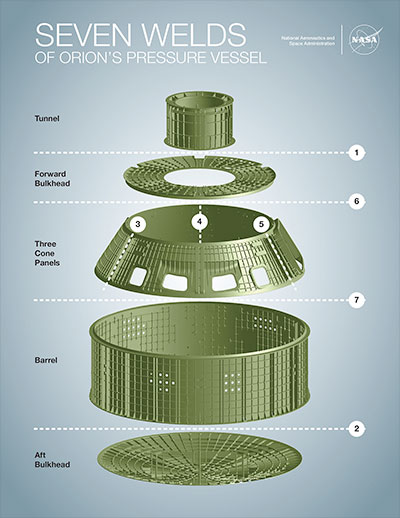 |
Robert Pearlman
Editor Posts: 53418
From: Houston, TX
Registered: Nov 1999
|
 posted 09-08-2015 06:03 PM
posted 09-08-2015 06:03 PM
   
The seven refers to the major component welds: The primary structure of Orion's crew module is made of seven large aluminum pieces that must be welded together in detailed fashion. |
Fra Mauro
Member Posts: 1739
From: Bethpage, N.Y.
Registered: Jul 2002
|
 posted 02-08-2016 06:08 PM
posted 02-08-2016 06:08 PM
   
Each milestone gets the adrenaline pumping a little in anticipation of the flight. I just hope the next President doesn't cancel the program. |
Robert Pearlman
Editor Posts: 53418
From: Houston, TX
Registered: Nov 1999
|
 posted 05-11-2016 08:39 AM
posted 05-11-2016 08:39 AM
   
Managers of the SLS, Orion, and Ground Systems Development and Operations (GSDO) programs said recently that while the programs are working towards a the launch of Exploration Mission 1 (EM-1) in November 2018, they believe that they could launch up to two months earlier, reports SpaceNews. "The agency's baseline commitment is November of 2018," said Mike Bolger, manager of the GSDP program. "The September date we've talked internally about, and pressed them to see if we can make it by September. It gives us a little margin at the end."His comments came after an earlier presentation by Mark Kirasich, the Orion program manager, who discussed preparations for the EM-1 launch, including photos of the pressure vessel of the spacecraft being assembled at the Kennedy Space Center. "This is the pressure vessel that, about 28 months from now, will be on its way towards the moon and into a distant retrograde orbit around the moon," he said, a timeframe that corresponds to a September 2018 launch. |
p51
Member Posts: 1785
From: Olympia, WA
Registered: Sep 2011
|
 posted 07-29-2016 07:03 PM
posted 07-29-2016 07:03 PM
   
quote:
Originally posted by Fra Mauro:
I just hope the next President doesn't cancel the program.
From the NASA folks at Marshall and JSC I've spoken with, the money's already been allocated for this and the SLS tests for at least once launch. I'm not sure how far the money goes past the SLS test flight, but I'd be crushed if they killed the first manned flight on an SLS...Crushed, but not the least bit surprised, that is. |
Robert Pearlman
Editor Posts: 53418
From: Houston, TX
Registered: Nov 1999
|
 posted 09-11-2016 11:47 AM
posted 09-11-2016 11:47 AM
   
Photos of the Exploration Mission-1 (EM-1) Orion under preparation at the Armstrong Operations and Checkout Building at Kennedy Space Center: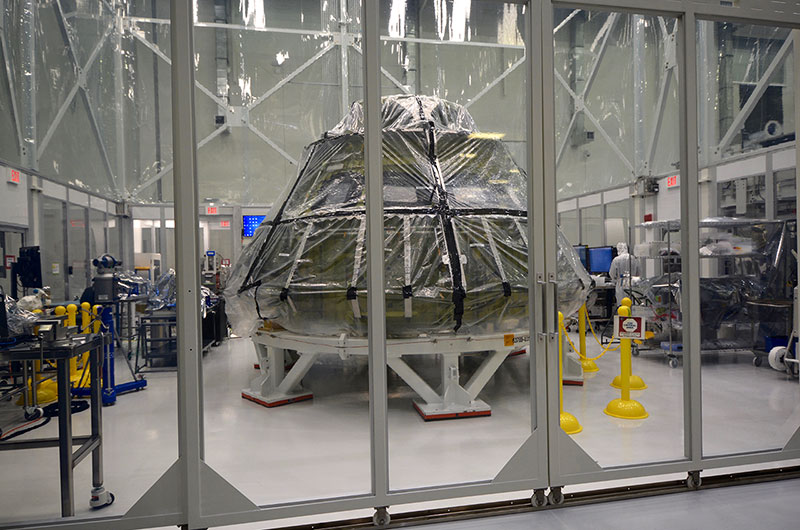 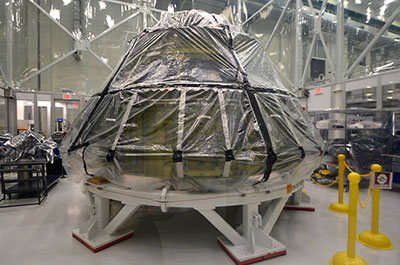
|
Robert Pearlman
Editor Posts: 53418
From: Houston, TX
Registered: Nov 1999
|
 posted 03-30-2017 08:02 AM
posted 03-30-2017 08:02 AM
   
Delays in the development of Orion's European-built service module, and damage to a NASA facility from a tornado, are the key schedule risks for the first Space Launch System mission, reports SpaceNews citing space agency officials. The schedule for the launch of Exploration Mission 1 (EM-1), currently planned for late 2018, remains uncertain regardless of the technical issues as NASA studies the possibility of putting a crew on the flight, which would likely delay it by up to a year.In a presentation to a meeting of the NASA Advisory Council's Human Exploration and Operations Committee here, Bill Hill, deputy associate administrator for exploration systems development, said service module delays and damage to the Michoud Assembly Facility in New Orleans from a February tornado are running "kind of neck and neck" about being the biggest issue with the existing schedule for EM-1. |
Robert Pearlman
Editor Posts: 53418
From: Houston, TX
Registered: Nov 1999
|
 posted 04-27-2017 02:45 PM
posted 04-27-2017 02:45 PM
   
A new report issued today (April 27) by the U.S. Government Accountability Office (GAO) includes confirmation from NASA that the space agency has slipped the launch of Exploration Mission-1 into 2019. In a letter responding to the report, Bill Gerstenmaier, Associate Administrator for Human Exploration and Operations, writes: We agree with the GAO that maintaining a November 2018 launch readiness date is not in the best interest of the program, and we are in the process of establishing a new target in 2019. Many of the specific concerns referenced in this report are no longer concerns, and new ones have appeared. Caution should be used in referencing the report on the specific technical issues, but the overall conclusions are valid. |
Robert Pearlman
Editor Posts: 53418
From: Houston, TX
Registered: Nov 1999
|
 posted 11-08-2017 06:08 PM
posted 11-08-2017 06:08 PM
   
NASA today released an update on the EM-1 target launch date: "While the review of the possible manufacturing and production schedule risks indicate a launch date of June 2020, the agency is managing to December 2019," said acting NASA Administrator Robert Lightfoot. "Since several of the key risks identified have not been actually realized, we are able to put in place mitigation strategies for those risks to protect the December 2019 date." |
Robert Pearlman
Editor Posts: 53418
From: Houston, TX
Registered: Nov 1999
|
 posted 03-26-2018 10:48 AM
posted 03-26-2018 10:48 AM
   
From today's (March 26) NASA Advisory Council human exploration and operations committee meeting, a mission chart for EM-1: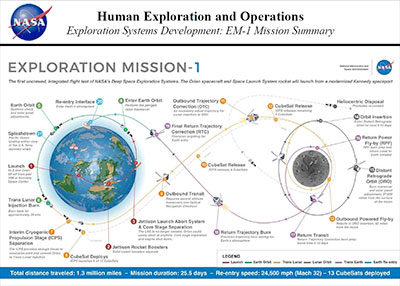 |
Blackarrow
Member Posts: 3766
From: Belfast, United Kingdom
Registered: Feb 2002
|
 posted 03-28-2018 05:55 PM
posted 03-28-2018 05:55 PM
  
Why is everything slower in today's spaceflight? "6 - 10 days" to return from the Moon? |
Robert Pearlman
Editor Posts: 53418
From: Houston, TX
Registered: Nov 1999
|
 posted 03-28-2018 07:31 PM
posted 03-28-2018 07:31 PM
   
Different orbits and different service module engines.Though they were from the same family of engines, the Apollo service module module engine, the AJ10-137, produced 20,500 lbf (91 kN) of thrust, while the Orion European service module uses the AJ10-190, the former space shuttle orbital maneuvering system engine, which produces 6,000 lbf (26.7 kN) of thrust. |
Blackarrow
Member Posts: 3766
From: Belfast, United Kingdom
Registered: Feb 2002
|
 posted 03-29-2018 08:40 PM
posted 03-29-2018 08:40 PM
  
Just as you get 24 by multiplying 12x2 or 6x4, surely a less powerful engine can achieve the same delta V by firing longer? It's a bigger spacecraft, so there is surely room for enough fuel to achieve the necessary delta V to return to Earth in the 3 days (or so) that it took Apollo. If a slower return produced a slower re-entry speed I could understand it, but it clearly doesn't. |
Robert Pearlman
Editor Posts: 53418
From: Houston, TX
Registered: Nov 1999
|
 posted 03-29-2018 09:16 PM
posted 03-29-2018 09:16 PM
   
Orion may be bigger than the Apollo command module, but the fuel isn't stored in Orion. The Orion service module is considerably smaller than the Apollo service module. It has a fuel capacity of 9,000 kg. The Apollo service module had a fuel capacity twice that. It is helpful to remember that the Apollo SPS engine was overkill for what the mission required. It was designed to lift the command and service module off the moon on a direct ascent, rather than lunar orbit rendezvous as flown. Had it been built for LOR, Apollo would have taken 6 to 10 days to return to Earth, too. |
Blackarrow
Member Posts: 3766
From: Belfast, United Kingdom
Registered: Feb 2002
|
 posted 03-30-2018 06:49 AM
posted 03-30-2018 06:49 AM
  
quote:
Originally posted by Robert Pearlman:
Had it been built for LOR, Apollo would have taken 6 to 10 days to return to Earth, too.
...and Apollo 13 would have been a whole different ball-game. |
Robert Pearlman
Editor Posts: 53418
From: Houston, TX
Registered: Nov 1999
|
 posted 08-27-2018 03:51 PM
posted 08-27-2018 03:51 PM
   
From today's (Aug. 27) NASA Advisory Council human exploration and operations committee meeting, an updated mission chart for EM-1: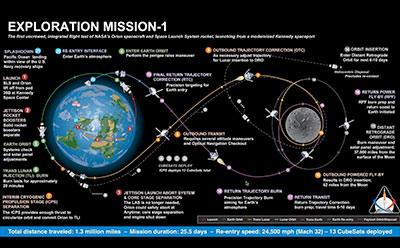 And a chart of milestones leading up to the mission: 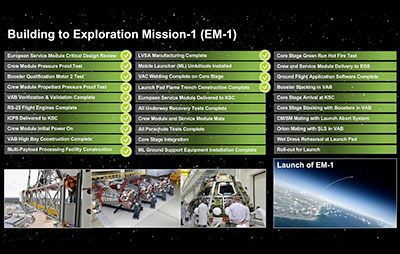 |
Blackarrow
Member Posts: 3766
From: Belfast, United Kingdom
Registered: Feb 2002
|
 posted 11-07-2018 07:49 AM
posted 11-07-2018 07:49 AM
  
The European-built service module that will propel, power and cool during Orion flight to the Moon on Exploration Mission-1 arrived from Germany at the agency's Kennedy Space Center in Florida on Tuesday to begin final outfitting, integration and testing with the crew module and other Orion elements. It certainly looks like it's all coming together. I just wish the pace of development was more like Apollo than the search for economic fusion-power. |
cspg
Member Posts: 6376
From: Geneva, Switzerland
Registered: May 2006
|
 posted 11-07-2018 08:04 AM
posted 11-07-2018 08:04 AM
   
Fusion-power is slow because it is under-funded much like SLS. And there's no deadline either. And as the vice president said (or implied), SLS is a jobs program so I'm not sure anyone is that interested in speeding up things. |
Robert Pearlman
Editor Posts: 53418
From: Houston, TX
Registered: Nov 1999
|
 posted 03-13-2019 10:28 AM
posted 03-13-2019 10:28 AM
   
NASA administrator Jim Bridenstine, speaking before the U.S. Senate Committee on Commerce, Science, and Transportation, opened the door to launching Exploration Mission-1 on commercial rockets. We are now understanding better how difficult this project is, and it's going to take some additional time. I want to be really clear. I think we as an agency need to stick to our commitment. If we tell you, and others, that we're going to launch in June of 2020 around the moon, I think we should launch around the moon in June of 2020. And I think it can be done. We should consider, as an agency, all options to accomplish that objective.The mission would work something like this. A heavy-lift rocket would launch Orion and its service module into low-Earth orbit. Another rocket would launch a fully fueled upper stage into orbit, which would then dock with Orion. This upper stage would provide the propulsion needed to push Orion out of low Earth orbit and inject it into lunar orbit. Bridenstine did not name the rockets under consideration... |
SpaceAholic
Member Posts: 5403
From: Sierra Vista, Arizona
Registered: Nov 1999
|
 posted 03-13-2019 12:08 PM
posted 03-13-2019 12:08 PM
   
Little over a year to adapt the proposed adjusted concept to implementation. Don't see how that is more readily achievable (within the relatively tight timeline). Lots of technical risk, which could do more to undermine the long term viability of Orion program if there is a rush to execute. |
Headshot
Member Posts: 1345
From: Vancouver, WA, USA
Registered: Feb 2012
|
 posted 03-14-2019 07:55 AM
posted 03-14-2019 07:55 AM
   
Yes, what Scott (SpaceAholic) said. |
Robert Pearlman
Editor Posts: 53418
From: Houston, TX
Registered: Nov 1999
|
 posted 03-14-2019 01:09 PM
posted 03-14-2019 01:09 PM
   
Message from NASA Administrator Jim Bridenstine A Message to the Workforce on SLS and OrionYesterday, I was asked by Congress about the schedule slip of the Space Launch System and plans to get NASA back on track. I mentioned that we are exploring the possibility of launching Orion and the European Service Module to low-Earth orbit on an existing heavy-lift rocket, then using a boost from another existing vehicle for Trans Lunar Injection. Our goal would be to test Orion in lunar orbit in 2020 and free up the first SLS for the launch of habitation or other hardware in 2021. This would get us back on schedule for a crewed lunar orbital mission in 2022 with the added bonus of a lunar destination for our astronauts. We are studying this approach to accelerate our lunar efforts. The review will take no longer than two weeks and the results will be made available. Please know that NASA is committed to building and flying the SLS for the following reasons: - Launching two heavy-lift rockets to get Orion to the Moon is not optimum or sustainable.
- Docking crewed vehicles in Earth orbit to get to the Moon adds complexity and risk that is undesirable.
- SLS mitigates these challenges and allows crew and payloads to get to the Moon, and eventually to Mars, safer and more efficiently than any temporary solution used to get back on track.
I believe in the strength of our workforce and our ability to utilize every tool available to achieve our objectives. Our goal is to get to the Moon sustainably and on to Mars. With your focused efforts, and unmatched talent, the possibility of achieving this objective is real. |
Robert Pearlman
Editor Posts: 53418
From: Houston, TX
Registered: Nov 1999
|
 posted 03-15-2019 11:40 AM
posted 03-15-2019 11:40 AM
   
From NASA Administrator Jim Bridenstine on Twitter: Good news: The NASA and Boeing teams are working overtime to accelerate the launch schedule of the Space Launch System. If achievable, this is the preferred option for our first exploration mission that will send the Orion capsule around the Moon. Still looking at options. |
Robert Pearlman
Editor Posts: 53418
From: Houston, TX
Registered: Nov 1999
|
 posted 03-26-2019 06:44 PM
posted 03-26-2019 06:44 PM
   
From a statement issued by NASA Administrator Jim Bridenstine: Earlier today I was also at Marshall Space Flight Center for an all-hands to reinforce our commitment to SLS with the workforce. We discussed my recent announcement that NASA would consider all options to fly Orion around the Moon on schedule. I shared the analysis we conducted to assess flying the Orion on different commercial options. While some of these alternative vehicles could work, none was capable of achieving our goals to orbit around the Moon for Exploration Mission-1 within our timeline and on budget. The results of this two-week study reaffirmed our commitment to the SLS. More details will be released in the future. |
Robert Pearlman
Editor Posts: 53418
From: Houston, TX
Registered: Nov 1999
|
 posted 04-01-2019 01:38 PM
posted 04-01-2019 01:38 PM
   
NASA Administrator Jim Bridenstine, speaking at a NASA town hall on Monday (April 1), summarized the reasons why a commercial approach to launching EM-1 was not viable. Running through the options: - Delta IV Heavy: alone it does not have the thrust to loft Orion and its service module around the moon, nor can it lift Orion, the service module and an Interim Cryogenic Propulsion Stage (ICPS).
- Two Delta IV Heavy rockets: The limit then becomes launch pads; only one Delta IV Heavy pad per coast and a single pad cannot be turned around quick enough to support a single mission. Launching the ICPS from the west coast into polar orbit takes too long and too much fuel to change planes to rendezvous with an Orion and service module launched from the east coast.
- Delta IV Heavy and Falcon 9: Only U.S. vehicle capable of an autonomous docking right now is Crew Dragon, but it does not have the thrust to send Orion and its service module around the moon.
- Falcon Heavy: It can loft the Orion, its service module and an ICPS on a single launch but major modifications would be needed to the launch erector and launchpad, the latter to support hypergolic loading in the vertical, which rules out a launch in 2020. The Falcon Heavy would also result in a lower than desired lunar orbit.
Bridenstine said that the Falcon Heavy could be a solution in the future, but was not capable of meeting the timeline and needs of the EM-1 mission.With regards to launching EM-1 on the Space Launch System (SLS) in 2020, he said one of the ways in which the program is shaving off months is by removing the engine section from the critical path for integrating the rocket's other segments. The agency has now purchased hardware to allow for the other tanks and upper sections of the SLS to be integrated in the horizontal as work to qualify the engine section is completed. NASA is also looking at what pre-launch tests it can do without, distinguishing between tests that must be done from those that are just tests they would like to perform but are not necessary. That may include the "Green Run" test of all four RS-25 engines together on a Stennis test stand, but that is still to be determined. |
Fra Mauro
Member Posts: 1739
From: Bethpage, N.Y.
Registered: Jul 2002
|
 posted 04-01-2019 05:29 PM
posted 04-01-2019 05:29 PM
   
We all knew that the use of commercial rockets for Orion was a hollow threat. Are the steps that the Administrator is proposing similar to "Go Fever" or full-up testing of the Saturn V? |
Robert Pearlman
Editor Posts: 53418
From: Houston, TX
Registered: Nov 1999
|
 posted 04-01-2019 05:52 PM
posted 04-01-2019 05:52 PM
   
At this point, neither; as of now, it is only reorganizing the order of work being done so that one piece (the engine section) does not hold up other progress that can be made.If NASA does decide to forgo the Green Run, then it is believed the agency will opt for shorter duration Flight Readiness Firing, similar to what was done during the early space shuttle program, on the launch pad. In that sense, yes, it will be more akin to Apollo-style all-up testing than individual component trials. |
oly
Member Posts: 1484
From: Perth, Western Australia
Registered: Apr 2015
|
 posted 04-01-2019 10:30 PM
posted 04-01-2019 10:30 PM
   
quote:
Originally posted by Robert Pearlman:
Bridenstine said that the Falcon Heavy could be a solution in the future, but was not capable of meeting the timeline and needs of the EM-1 mission.
What timeframe would be required to do the necessary modifications and improvements, and what cost versus developing the SLS for the Block 1, which will eventually need an upgrade development to Block 2 specs? This seems like something that could be done by a third party or contractor within a defined budget.Would the cost of using the Falcon Heavy center first stage through to fuel depletion, rather than perform the burn back and landing, be a cheaper option? Will sacrificing the centre rocket provide the desired loft? Does the SpaceX BFR planned heavy lift capability and planned flight test schedule overlap the SLS plans in any way? It may be embarrassing for SLS fly after BFR, with similar stated payloads to lunar orbit capability. The SLS/Orion payload diameter is smaller than BFR, so any adapter or fairing should be feasible. |
Robert Pearlman
Editor Posts: 53418
From: Houston, TX
Registered: Nov 1999
|
 posted 04-01-2019 10:40 PM
posted 04-01-2019 10:40 PM
   
SpaceX's Super Heavy does not exist. Until it does, it is not an option for NASA.Pad 39A is needed to support commercial crew. Taking the pad out of service to support EM-1 is not an option for NASA. This is not a question of cost. NASA's priority is to launch EM-1 in 2020. Falcon Heavy cannot support that, so it is not an option. |
oly
Member Posts: 1484
From: Perth, Western Australia
Registered: Apr 2015
|
 posted 04-01-2019 11:29 PM
posted 04-01-2019 11:29 PM
   
I agree with your points Robert, but given that SLS has received heavy criticism since inception, including statements like "SLS will consume the funds for other projects from the NASA budget and will not reduce launch costs" (via Wikipedia) it seems that to now cry out for additional funding to bring the system online just reinforces what the critics have been saying for years.I get why the commitment to SLS exists, and I hope that the system becomes a huge success that can be used for great things. But between the adoption of the SLS, born out of the Constellation program and the demise of the space shuttle program, there have been some advancements in rocket reusability, efficiency and weight savings, especially with avionics and computing. The Orion spacecraft and systems needs to be test flown, and crews need flight experience before some Hail Mary lunar landing mission can be achieved. This does not require SLS to achieve. If Falcon Heavy exists today, can get the equipment to space, on station for the test requirements, why not work with SpaceX to achieve this, while continuing with the existing plans for SLS, without seeking additional funds that will be sunk into a Block 1 rocket that is planned to be superseded after a few flights? There would have to be some concessions made by NASA, they would need to allow the use of flown rockets on manned flights, but this was what SpaceX designed them for anyway, and NASA is considering making concessions with the unproven SLS to achieve and earlier flight. This would also be a good test for the new flight approval rules being introduced, in that more flights could be introduced into a pre-existing schedule without much hassle. SpaceX stated that their intention was for rapid turnaround, which is something that NASA and the US space industry could all benefit from. It seems that either way, more money is required. investment into systems that promote reusability, increased flight rates, more and cheaper missions would be more prudent than investing in a system with very limited options. SLS resources are finite, the engines are limited in quantity, and to build more engines and solid rockets is a huge expense. What happens if one of the SLS test flights has an issue that requires the complete mission to be re-flown, the number of subsequent missions drops by one unless more throw away engines and rockets parts are made. I threw the Super Heavy option in to the mix because it is a system under development, that is designed to have a similar payload capability, and would benefit with a similar level of investment, but would be a better system once completed (because it could be re-used). NASA could also use the Super Heavy system to lift future space station or Hubble type rescue missions using Orion and some kind of maintenance platform, so the investment would be multi platform. To say Super Heavy does not exist, while SLS is still being pieced together, and thus should not be considered, negates the whole purpose of discussion. |
Robert Pearlman
Editor Posts: 53418
From: Houston, TX
Registered: Nov 1999
|
 posted 04-02-2019 11:32 AM
posted 04-02-2019 11:32 AM
   
NASA has decided that the only the way forward for EM-1 is an SLS launch, and so it is no longer pursuing any alternate. The White House and members of Congress (as of today) has expressed support for this approach. NASA has left open the possibility that Falcon Heavy may be an option for future Orion missions, but that is a topic for a different thread. |
issman1
Member Posts: 1143
From: UK
Registered: Apr 2005
|
 posted 04-02-2019 12:45 PM
posted 04-02-2019 12:45 PM
  
No longer pursuing SpaceX's Falcon Heavy as an alternate carrier rocket and (doubtless) no longer concerned about meeting any launch schedule. Makes one wonder why Bridenstine ever raised the issue, if only to yield so risibly to NASA's prime contractors and political paymasters. |
Robert Pearlman
Editor Posts: 53418
From: Houston, TX
Registered: Nov 1999
|
 posted 04-02-2019 01:01 PM
posted 04-02-2019 01:01 PM
   
Falcon Heavy has been ruled out for EM-1 specifically because NASA is working toward the constraint of launching the mission in late-2020. Were it not for that timeline, Falcon Heavy would still be an option. The possibility of using Falcon Heavy was raised because NASA was looking to see if another option to SLS existed. They looked, it does not for the reasons explained above. |
Robert Pearlman
Editor Posts: 53418
From: Houston, TX
Registered: Nov 1999
|
 posted 04-26-2019 12:24 PM
posted 04-26-2019 12:24 PM
   
quote:
Originally posted by Robert Pearlman:
If NASA does decide to forgo the Green Run...
In a memo shared with senior agency managers earlier this week, NASA's chief of human spaceflight, William Gerstenmaier, said the green run test would proceed, reports Ars Technica. "Ultimately, it was my recommendation to the agency that we stay the course with the plan that we have had for many years," Gerstenmaier wrote in the memo, dated April 22, which Ars obtained. "Although there is no certainty in when we launch, I believe this is the best approach to achieving a successful EM-1 flight test and put NASA on the path to achieving an EM-2 crewed mission in 2022 and a Lunar Surface mission in 2024."...in announcing his decision, Gerstenmaier also expressed the need for urgency. "We must, however, have a higher degree of urgency in accomplishing EM-1 and beyond," Gerstenmaier wrote. "I ask the entire NASA/Industry community to diligently work toward the earliest EM-1 launch possible, to identify ways that we can be more efficient, and to continue to pay attention to detail to enable NASA [to have] a successful EM-1." He closed his letter by saying, "Urgency is our mantra and we must do it right." The agency has not commented publicly on the memo. On Thursday, a spokeswoman told Ars of the green run decision, "We’re still assessing and no final decisions have been made." |
Robert Pearlman
Editor Posts: 53418
From: Houston, TX
Registered: Nov 1999
|
 posted 05-31-2019 10:10 AM
posted 05-31-2019 10:10 AM
   
Exploration Mission-1 has now been renamed Artemis-1. |
ff27tls
Member Posts: 23
From: Brecksville
Registered: Feb 2005
|
 posted 11-26-2019 01:06 PM
posted 11-26-2019 01:06 PM
   
NASA's Super Guppy aircraft arrived at Mansfield Lahm Airport in Ohio with the Orion spacecraft for Artemis 1 aboard on Sunday (Nov. 24). The Orion was being transported to the Plum Brook Station for testing. I was at Lahm Airport for the arrival and offloading and took these photos. 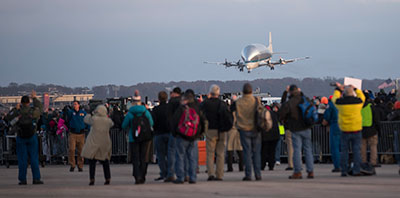 
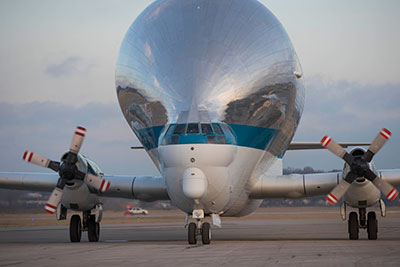
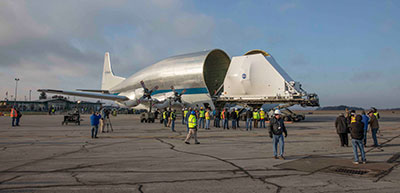
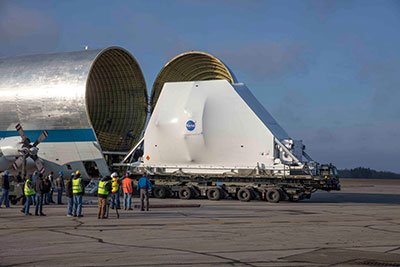
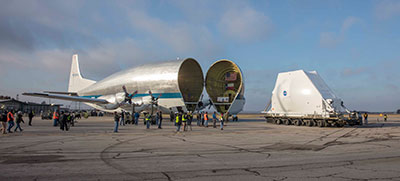
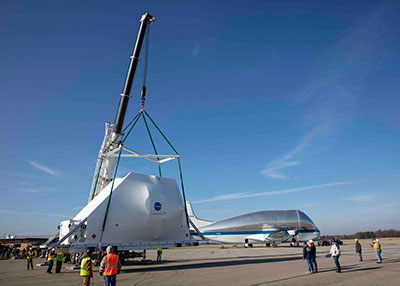
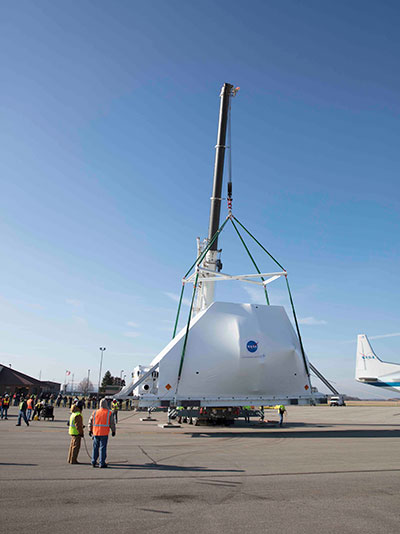
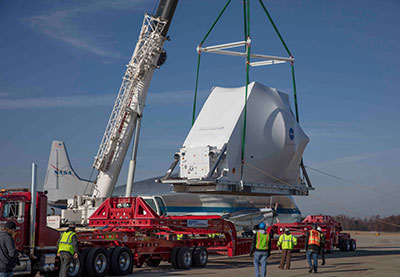
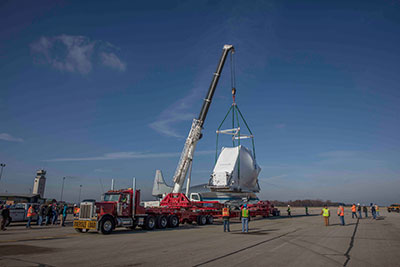
|



























